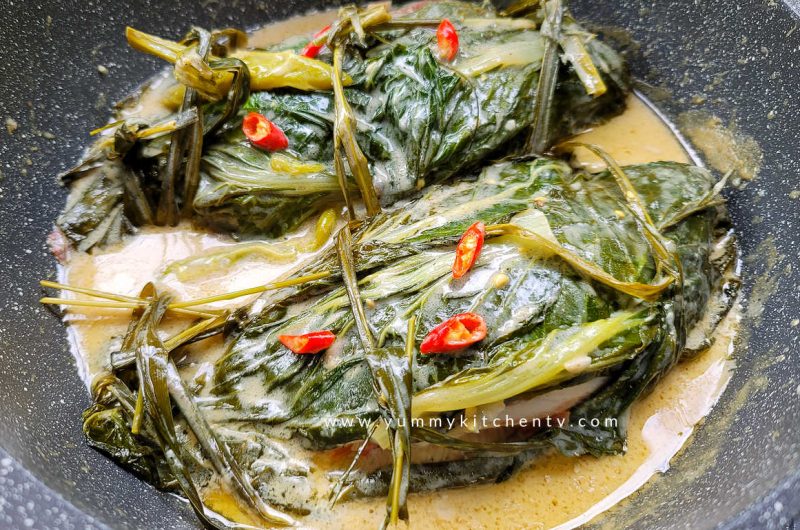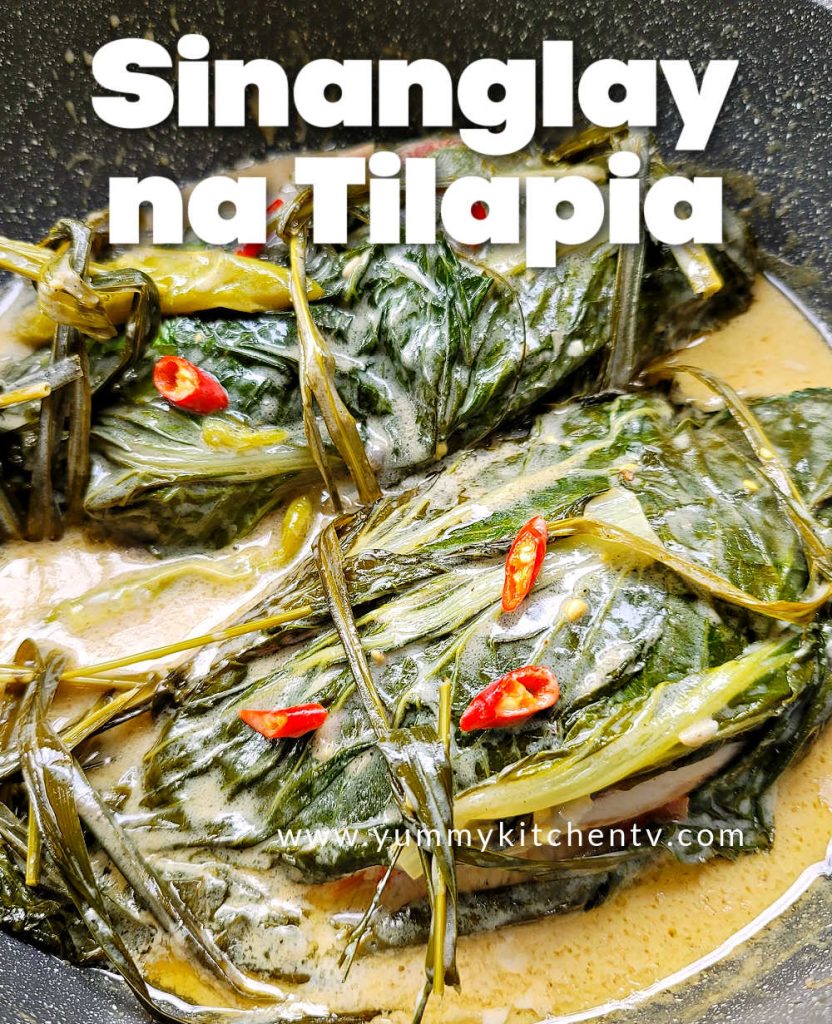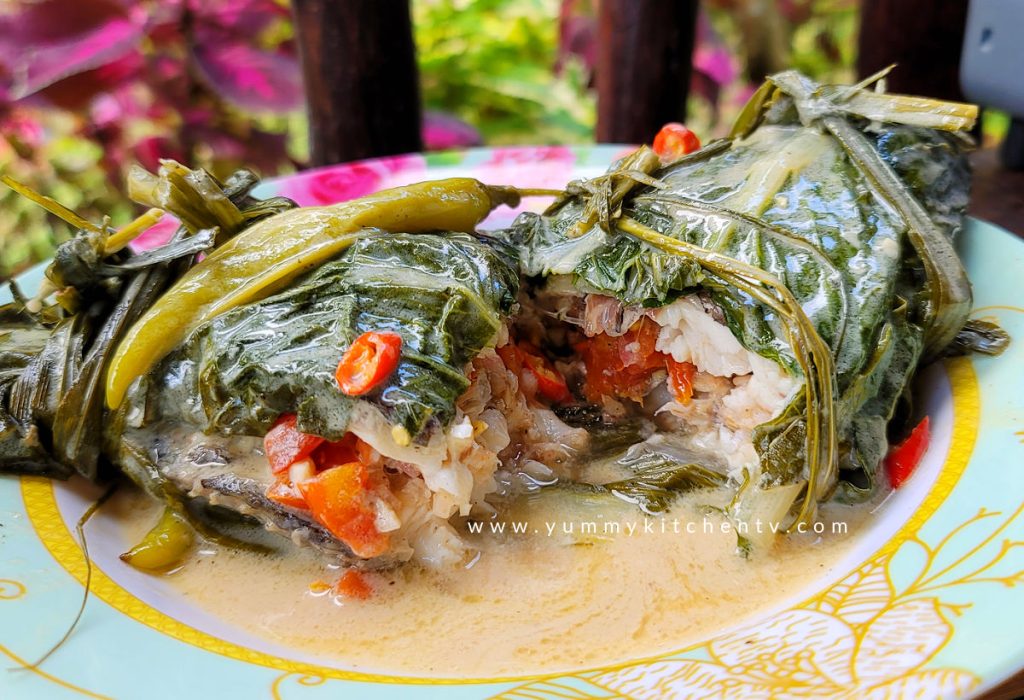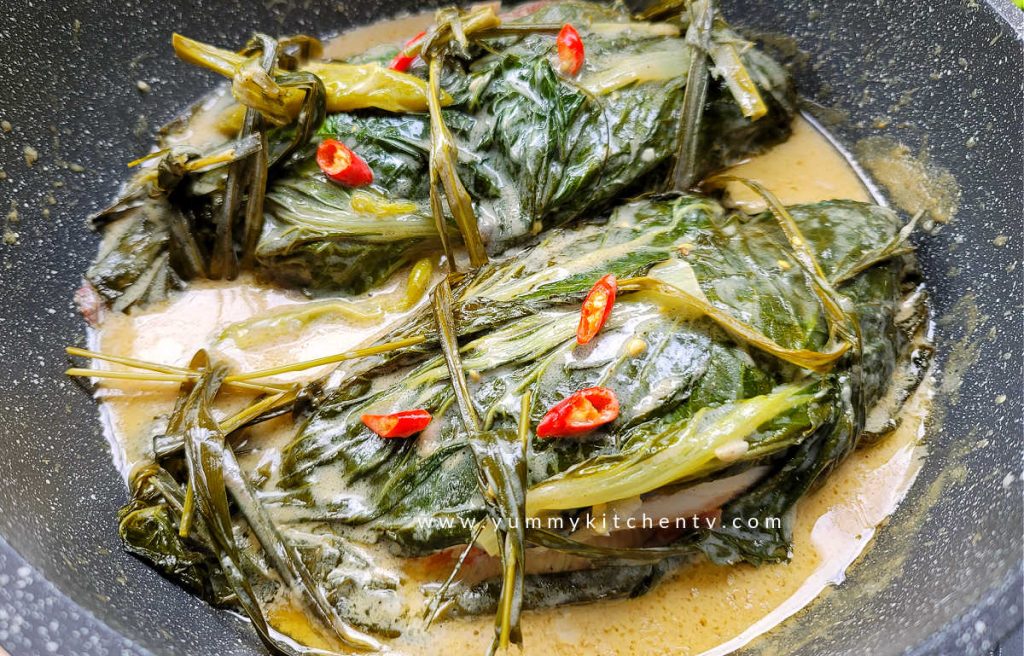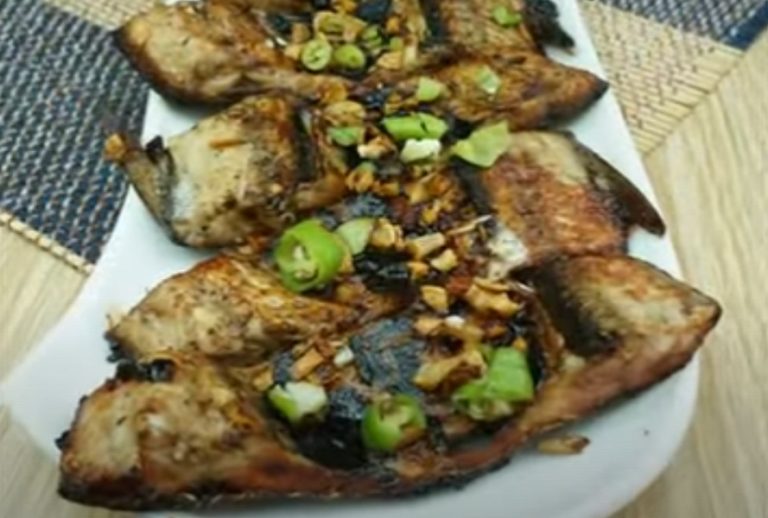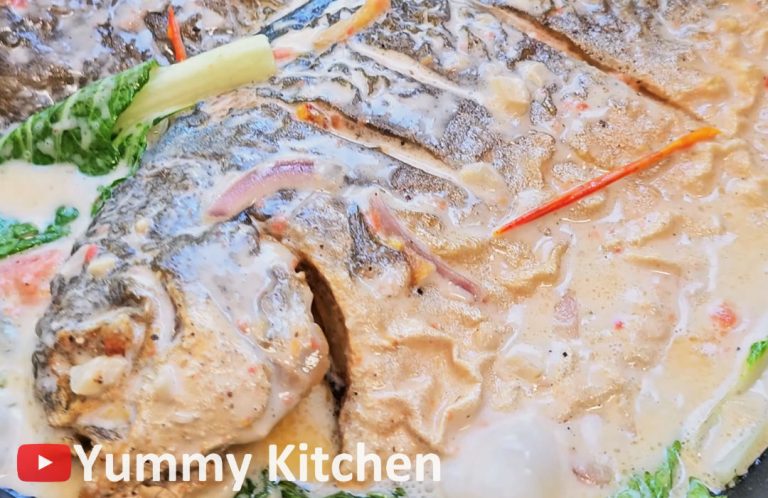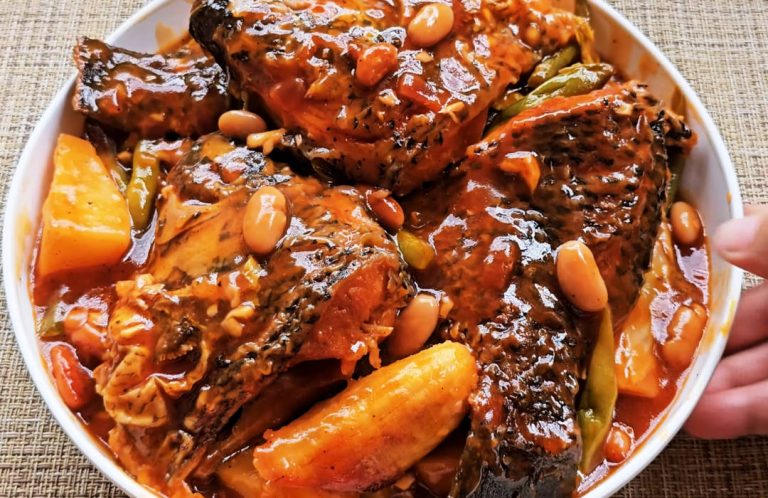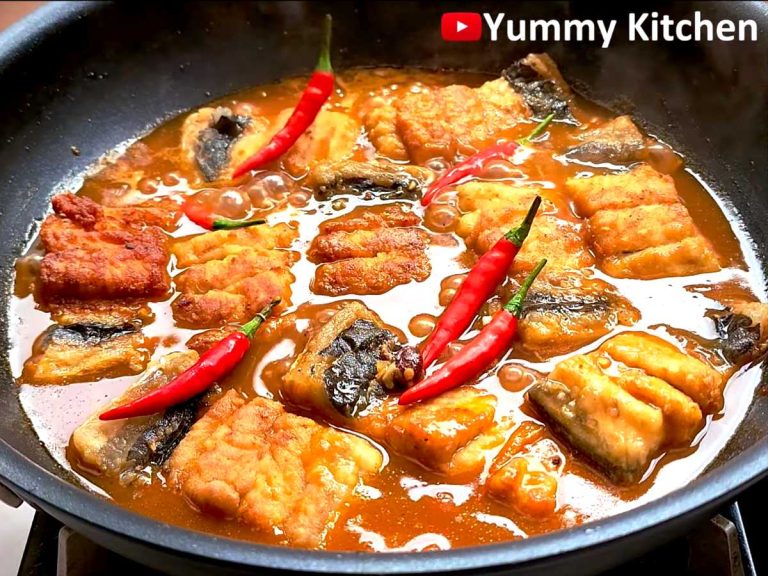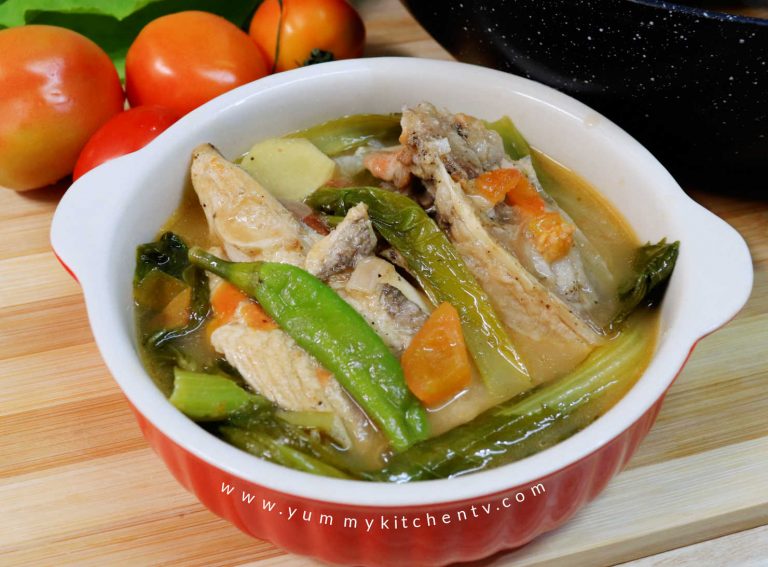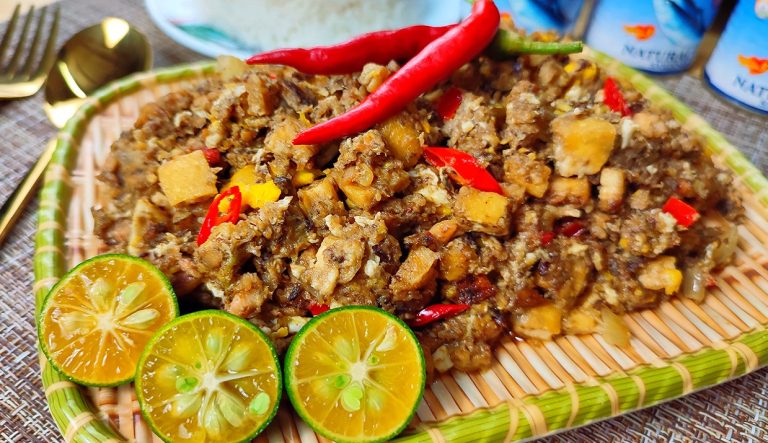Sinanglay na Tilapia
Sinanglay na tilapia is a Filipino dish, where fresh tilapia is stuffed with tomatoes, onion, garlic, ginger, sinigang mix, salt and pepper and wrapped with pechay leaves and tanglad leaves then cooking in a coconut milk based cream. This dish uses the traditional Filipino cooking technique “sanglay” which involves wrapping the fish in fragrant tanglad (lemongrass) and pechay (Chinese cabbage) leaves, allowing the flavors to infuse while steaming. Make sure to partner your sinanglay na tilapia to a big bowl of hot steaming rice. Yum!
Sinanglay na Tilapia Recipe
Ingredients:
- 4 medium tomatoes (chopped)
- 1 medium onion (chopped)
- 3 cloves of garlic (minced)
- 1 tablespoon ginger (minced)
- 20 grams Sinigang Mix
- 1/2 teaspoon salt
- 1/2 teaspoon black pepper
- 2 large tilapia
- lemongrass leaves (for wrapping)
- pechay leaves (for wrapping)
- 2 cups coconut cream
- 3 green chilies
- chopped red chilies (optional)
Directions:
- In a small bowl, combine the chopped tomatoes, onions, minced garlic, ginger and sinigang mix. Season with some salt and pepper. Mix until well combined. Set aside.
- Wash and prepare the tilapia. Rub with salt on both sides. Slice the top side of the fish to create a hole at the center. Open the cavity and stuff the center using the filling made earlier. Once fully stuffed, set aside.
- Arrange the tanglad leaves and pechay leaves on a clean, flat surface. Place the tilapia on top and then add more pechay leaves to wrap the fish completely. Secure the wrap by tying the lemongrass leaves. Do the same steps to the other tilapia.
- Arrange the wrapped tilapia to a pan. Pour the coconut cream and sprinkle some salt and pepper. Add the green chilies. Cover the pan and let this cook for 25 – 30 minutes using medium low heat. Pour the sauce over the wrap from time to time to cook evenly.
- You may add chopped red chilies if you want it to be spicier. Once the pechay leaves are fully softened, then the dish is ready. Turn the heat off.
- Transfer the sinanglay na tilapia to a serving plate. Enjoy this with a lot of hot steaming rice. Yum!
What is Sinanglay?
Sinanglay is a Filipino cooking technique that involves wrapping fish or seafood in a fragrant mixture of herbs and spices, usually in banana leaves or pechay leaves, and then simmering it in a flavorful sauce. The term “sinanglay” is derived from the Filipino word “sanglay,” which means “to wrap” or “to envelop.”
Sinanglay is a popular method of cooking various types of fish in the Philippines, with tilapia being a common choice. The technique is known for preserving the natural flavors of the fish while allowing the aromatics and sauce to permeate and enhance its taste. The resulting dish is often served with rice and enjoyed for its delicate flavors and tender texture.
Sinanglay is a popular dish in the Philippines, particularly in the Southern Tagalog region, which includes provinces like Batangas, Laguna, and Quezon. These areas are known for their abundance of freshwater fish, making sinanglay a common and beloved dish among the local communities.
In Batangas, specifically, sinanglay is highly regarded and considered a specialty dish. The province’s proximity to Taal Lake, which is known for its tilapia and other freshwater fish, has contributed to the popularity of sinanglay in the area.
Sinanglay na Tilapia
Recently I have been teaching my new niece on how to wrap lumpia and she really enjoyed it. We have already made stocks of ready to cook lumpia at home and her eagerness in wrapping things just went out of hand. It is still far away from my birthday but my niece had already wrapped her gift for me.
With this, I introduced another wrapped dish which she liked in an instant. The sinanglay na tilapia includes a unique way of wrapping, which uses tanglad leaves as a rope/twine to seal it. Since she was still not allowed near the stove, I just showed her how I stuff and wrap the fish and made her do the steps to the other tilapia. She was eagerly waiting for the dish to cook and excitedly unwrapped her sinanglay as I served it to her plate. She called the sinanglay “a dish which presents itself as a gift”, which is indeed true.
If you wanna know how to make sinanglay na tilapia at home, simply read and follow the easy steps below. Happy cooking!
How to Cook Sinanglay na Tilapia
Making some sinanglay na tilapia is very easy. If you made other wrapped dishes in the past, then this dish will be easy for you.
While the sinanglay cooking technique can be applied to different types of fishes, the most popular and most convenient when it comes to shape and size wouldb be the tilapia.
For this recipe, choose the best and freshest tilapia you can get. Our target size ranges from medium to large, as we need to stuff them later. Just like any stuffed dishes, make a slit on the top (or bottom) of the tilapia where we can put finely minced aromatics which will infuse all their flavors in the fish. Once stuff, papunta palang tayo sa exciting na part. *laughs*
The next and the most fun part in making this dish is the wrapping part. Most sinangalay dishes uses large leaves like pechay, chinese pechay or mustard leaves. Choose the leaves you want and wrap the tilapia. Tanglad leaves, being long, is usually used to tie and finalize the wrap. E
The last part would be simmering the wrapped fish in coconut milk. While cooking, do not flip or move the tilapia too much as you might destroy the wrap prematurely. You can baste the coconut milk for a few times just so the top part would also cook in time.
When the leaf wrappers are already soft, there’s a high chance that the tilapia is also cooked. Transfer the sinanglay na tilapia to a serving plate. Only open the wrap when you’re ready to eat. I usually partner this with hot steaming rice. Yum!
Paano Magluto ng Sinanglay na Tilapia
Mga Sangkap:
- 4 pirasong kamatis (hiniwa)
- 1 pirasong sibuyas (hiniwa)
- 3 butil ng bawang (hiniwa ng maliliit)
- 1 kutsaritang luya (hiniwa ng maliliit)
- 20 gramo ng Sinigang Mix
- 1/2 kutsaritang asin
- 1/2 kutsaritang paminta
- 2 malalaking tilapia
- dahon ng tanglad (pangbalot)
- dahon ng pechay (pangbalot)
- 2 tasang gata
- 3 siling pansigang
- hiniwang siling labuyo (optional)
Paano Lutuin:
- Sa isang maliit na bowl, paghaluin ang hiniwang mga kamatis, sibuyas, bawang, luya, at Sinigang Mix. Budburan ito ng kaunting asin at paminta. Haluin ng mabuti at isantabi.
- Hugasan at ihanda ang mga tilapia. Pahiran ng asin ang parehong side. Hiwain ang itaas na bahagi ng isda para magkaroon ng butas. Buksan ang hiwa at punuin ng ginawang aromatic mixture. Kapag puno na ito, isantabi muna.
- Iayos ang mga dahon ng tanglad at dahon ng pechay sa malinis at patag na surface. Ilagay ang tilapia sa ibabaw at magdagdag ng dahon ng pechay sa ibabaw para mabalot nang buo ang isda. Gamitin ang mga dahon ng tanglad bilang pantali. Gawin ang mga steps na ito sa ibang tilapia.
- Ilagay ang mga wrapped tilapia sa kawali. Ibuhos ang gata at budburan ng kaunting asin at paminta. Sunod na ilagay ang mga siling pansigang. Takpan ang kawali at lutuin ito ng 25 – 30 minuto gamit ang katamtamang apoy. Buhus-buhusan ng sauce sa ibabaw ng mga tilapia upang maluto ng pantay.
- Kung gusto mo ng maanghang na version, pwede mo itong dagdagan ng hiniwang siling labuyo (o chili flakes). Kapag malambot na ang mga dahon ng pechay, ibig sabihin ay luto na rin ang isda. Patayin ang apoy.
- Ilipat ang sinanglay na tilapia sa isang serving plate. Ihain ito kasama ang maraming mainit na kanin. Yum!


